Reserve Bank of Australia Annual Report – 2014 Earnings and Distribution
Balance Sheet
The Reserve Bank holds a portfolio of financial assets to conduct operations in financial markets in order to pursue its monetary policy objectives and support an efficient and orderly payments system in Australia. In particular, these assets are the basis for transactions to manage liquidity in the cash market in Australia, and thereby implement monetary policy. They include Australia's foreign exchange reserves and domestic securities. The Bank's financial liabilities mainly comprise banknotes on issue, deposits of the Australian Government and other customers, and capital and reserves.
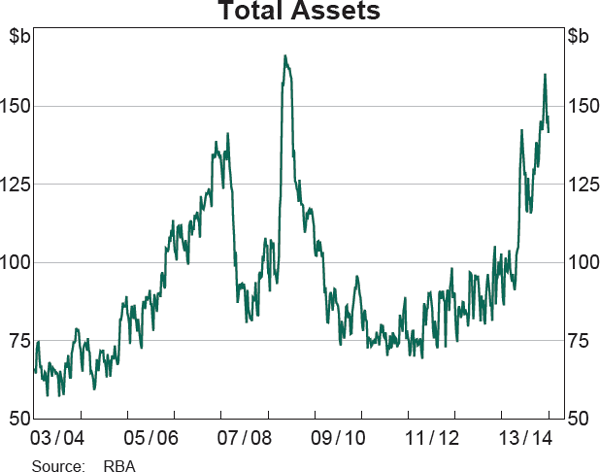
The Reserve Bank's balance sheet expanded significantly in 2013/14, to about $141 billion at the end of the financial year, compared with $99 billion a year earlier. This expansion was largely due to the start of same-day settlement of direct entry payments in November 2013. Under these arrangements, banks have higher demand for liquidity and balances held in Exchange Settlement (ES) accounts rose accordingly to assist banks meet their interbank payment obligations after the cash market closes each day. Banks funded the higher ES balances by contracting RBA open repurchase agreements available to holders of ES accounts; ‘open repos’ are a domestic asset on the Bank's balance sheet. Deposits of the Australian Government also increased in 2013/14, while capital and reserves rose with the receipt of the proceeds of the Commonwealth grant of $8.8 billion. Banknotes in circulation, the Bank's largest liability, rose by about 7 per cent.
These movements in liabilities were reflected in the Reserve Bank's investments, with both domestic and foreign exchange assets increasing. Management of the Bank's assets is discussed in the chapter on ‘Operations in Financial Markets’; the associated risks are considered in the chapter on ‘Risk Management’.
Earnings
The Reserve Bank's earnings in most years come from two sources – underlying earnings and valuation gains or losses. As noted above, in 2013/14 the Bank received a grant from the Commonwealth, which, as revenue, passes through the Profit and Loss account in accordance with Australian Accounting Standards (AAS).
Underlying earnings arise because the Reserve Bank earns interest on almost all of its assets, while it pays no interest on a large portion of its liabilities, including banknotes in circulation and capital and reserves. Valuation gains and losses result from fluctuations in the value of the Bank's assets, because of movements in exchange rates or in the yields on the securities it holds. An appreciation of the Australian dollar or a rise in interest rates reduces the value of assets and leads to valuation losses. Conversely, a depreciation of the Australian dollar or a decline in interest rates results in valuation gains. Valuation gains and losses are realised only when the underlying asset is sold. Valuation gains and losses are volatile, as both exchange rates and market interest rates can fluctuate in wide ranges over time. The Bank manages these market risks within strict parameters determined by its responsibility for monetary policy.
In accordance with AAS, the Reserve Bank reports net profit as income from all sources, while the distribution of profits is determined by section 30 of the Reserve Bank Act 1959. In terms of the Reserve Bank Act, the distribution of net profit is determined in the following way:
- Unrealised gains (or losses) are not available for distribution and are transferred to (or absorbed by) the unrealised profits reserve. The balance of this reserve is available to absorb future valuation losses or it tends to be distributed gradually over time as these gains are realised when relevant assets are sold.
- Net profit that remains after the transfer of unrealised gains or losses is available for distribution. The Treasurer determines, after consulting the Reserve Bank Board, any amounts to be placed from distributable earnings to the credit of the Reserve Bank Reserve Fund (RBRF), the Bank's permanent reserve.
- The remainder of earnings is payable as a dividend to the Commonwealth.
The Reserve Bank recorded a net profit of $9,392 million in 2013/14, comprising:
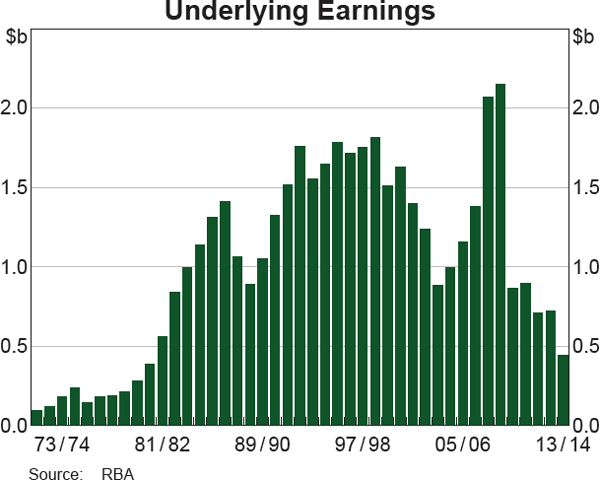
- underlying earnings of $442 million, an exceptionally low level in historical terms, which reflects the protracted period of low interest rates globally
- net total valuation gains of $150 million. Gains of $790 million were realised mainly as some unrealised gains accumulated the previous year were realised in 2013/14 as foreign currency was sold in the course of managing the portfolio of foreign reserves
- the Commonwealth grant of $8,800 million.
Excluding the unrealised losses of $640 million from net profit, distributable earnings, including proceeds from the Commonwealth grant, amount to $10,035 million in 2013/14. Excluding the grant, these earnings were $1,235 million.
The pattern of net profit over the longer term, and the pattern for valuation gains and losses, are shown in the graphs below.
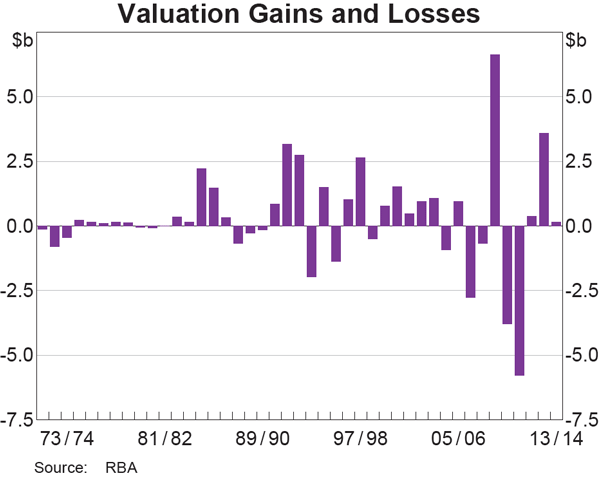
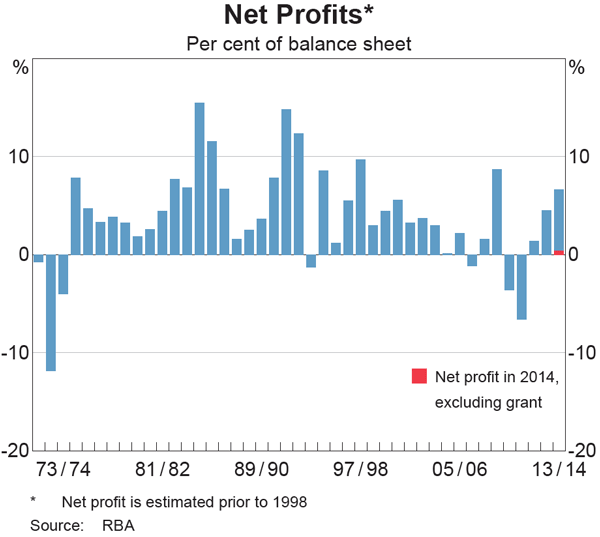
Capital, Reserves and Distribution
The RBRF is the Reserve Bank's general reserve and is essentially its capital. As noted above, the RBRF is funded from transfers from earnings available for distribution. Its purpose is to provide the capacity to absorb losses when it is necessary to do so. Large valuation losses as the exchange rate rose in 2009/10 and 2010/11 substantially depleted the RBRF. As a result, the balance of this reserve fell to a level that was significantly lower than the Board judged to be prudent. While the process of rebuilding this reserve had begun in recent years, it seemed likely that this would take an unacceptably long time if the Bank were to rely exclusively on replenishing the RBRF out of its profits, particularly if interest rates remained around current low levels. The decision of the Australian Government to make a grant to the Bank and boost its net profits provided the potential for a large transfer to the RBRF so that the balance of this reserve could be lifted immediately to an appropriate level. This approach was adopted to add to the Bank's capital because no other mechanism is available in terms of the Reserve Bank Act for the government to add directly to these resources.
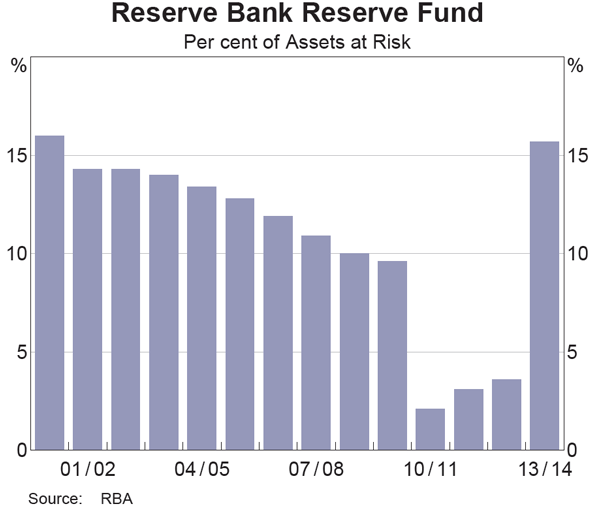
In the event, the Treasurer, after consulting the Board, determined that a sum of $8,800 million, the equivalent of the proceeds of the grant, be placed to the credit of the RBRF. Following this transfer, the balance of the RBRF stood at $11,159 million as at 30 June 2014, a level the Board regards as providing the Bank with strong resources against the risks it faces at present. The remainder of net profit, a sum of $1,235 million, was payable as a dividend to the Commonwealth. The Treasurer decided that an amount of $618 million of this dividend would be paid in August 2014 and the remainder would be paid in 2015/16. This decision is at the Treasurer's discretion and such an approach to receiving the dividend has occurred in a number of previous years.
Unrealised losses of $640 million were absorbed by the unrealised profits reserve in 2013/14, resulting in the balance of this reserve falling to $3,156 million at the end of the financial year.
In terms of AAS, asset revaluation reserves are held for non-traded assets, such as gold holdings and property, plant and equipment. Balances in these reserves represent the difference between the market value of these assets and the cost at which they were acquired. The total balance for these reserves stood at $3,978 million at 30 June 2014, $273 million higher than in the previous financial year, largely reflecting the increase in the Australian dollar value of the Reserve Bank's holdings of gold.
A superannuation reserve was established in the accounts for 2013/14, as the counterpart to movements in other comprehensive income from remeasurement gains and losses on the Reserve Bank's defined benefit superannuation obligation. The balance of this reserve was a debit of $23 million as at 30 June 2014, compared with a debit of $178 million a year earlier.
Details on the composition and distribution of the Reserve Bank's profits are contained in the table on page 79.
The Financial Statements (and accompanying Notes to the Financial Statements) for the 2013/14 financial year were prepared in accordance with AAS, consistent with the Finance Minister's Orders for Financial Reporting issued under the Commonwealth Authorities and Companies Act 1997.

| Composition of profits | Distribution of profits | Payments to government | |||||||||||
|---|---|---|---|---|---|---|---|---|---|---|---|---|---|
| Transfer to/from(−) | |||||||||||||
|
Underlying earnings
|
Realised gains and losses(-)(a) | Unrealised gains and losses(-) | Net profit or loss(-) | Unrealised profits reserve | Asset revaluation reserves | Reserve Bank Reserve Fund | Dividend payable | Payment from previous year's profit | Payment delayed from previous year | Total payment | |||
| 1997/98 | 1,750 | 966 | 1,687 | 4,403 | 1,687 | −558 | 548 | 2,726 | 1,700 | – | 1,700 | ||
| 1998/99 | 1,816 | 2,283 | −2,773 | 1,326 | −2,349 | −1 | – | 3,676 | 2,726 | – | 2,726 | ||
| 1999/00 | 1,511 | −708 | 1,489 | 2,292 | 1,489 | – | – | 803 | 3,000 | – | 3,000 | ||
| 2000/01 | 1,629 | 1,200 | 320 | 3,149 | 320 | −5 | – | 2,834 | 803 | 676 | 1,479 | ||
| 2001/02 | 1,400 | 479 | −11 | 1,868 | −11 | −10 | – | 1,889 | 2,834 | – | 2,834 | ||
| 2002/03 | 1,238 | 1,157 | −222 | 2,173 | −222 | −2 | 133 | 2,264 | 1,889 | – | 1,889 | ||
| 2003/04 | 882 | −188 | 1,261 | 1,955 | 1,261 | – | – | 694 | 1,300 | – | 1,300 | ||
| 2004/05 | 997 | 366 | −1,289 | 74 | −1,289 | – | – | 1,363 | 374 | 964 | 1,338 | ||
| 2005/06 | 1,156 | 4 | 933 | 2,093 | 933 | −17 | – | 1,177 | 1,063 | 320 | 1,383 | ||
| 2006/07 | 1,381 | 72 | −2,846 | −1,393 | −2,475 | −3 | – | 1,085 | 1,177 | 300 | 1,477 | ||
| 2007/08 | 2,068 | 614 | −1,252 | 1,430 | 27 | – | – | 1,403 | 1,085 | – | 1,085 | ||
| 2008/09 | 2,150 | 4,404 | 2,252 | 8,806 | 2,252 | – | 577 | 5,977 | 1,403 | – | 1,403 | ||
| 2009/10 | 866 | −128 | −3,666 | −2,928 | −2,248 | – | −680 | – | 5,227 | – | 5,227 | ||
| 2010/11 | 897 | −1,135 | −4,651 | −4,889 | −23 | – | −4,866 | – | – | 750 | 750 | ||
| 2011/12 | 710 | 405 | −39 | 1,076 | −20 | – | 596 | 500 | – | – | – | ||
| 2012/13 | 723 | −135 | 3,725 | 4,313 | 3,725 | – | 588 | – | 500 | – | 500 | ||
| 2013/14 | 9,242(b) | 790 | −640 | 9,392 | −640 | −3 | 8,800 | 1,235 | – | – | – | ||
| 2014/15 | 618 | – | 618 | ||||||||||
| 2015/16 | 618 | ||||||||||||
|
(a) Excludes gains or losses realised from the sale of fixed assets that
had been held in Asset Revaluation Reserves Source: RBA |
|||||||||||||